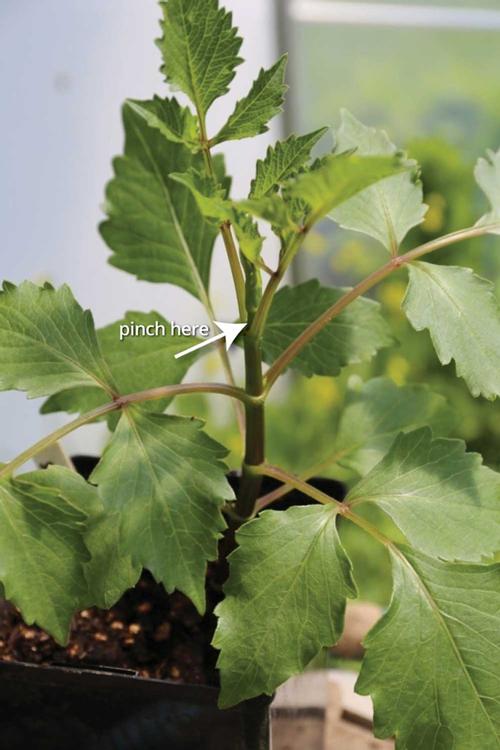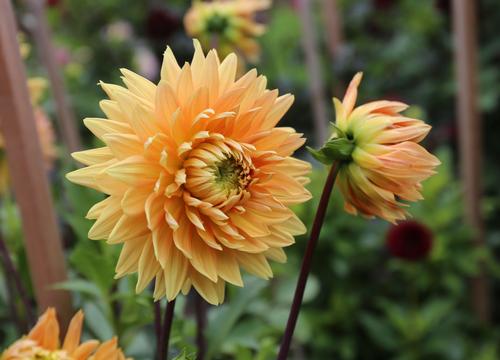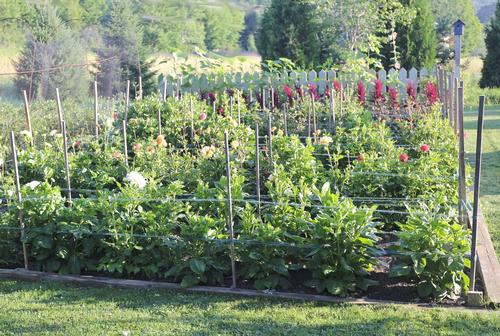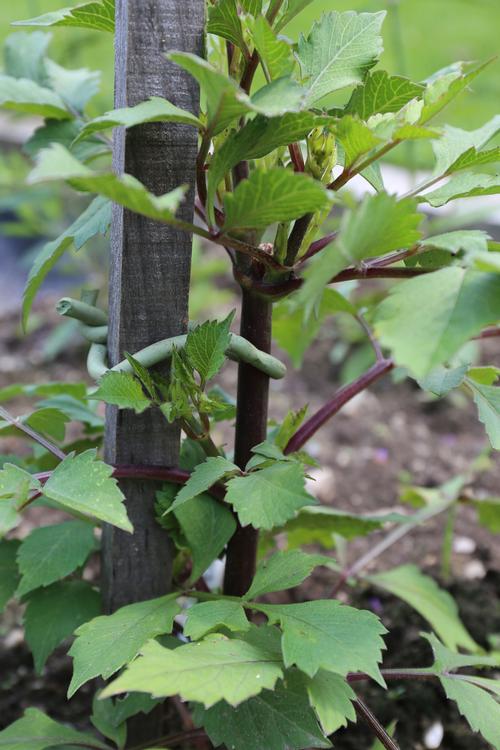Easy Ways to Increase Flower Production
Dahlias are attractive plants, but growing them is really all about the flowers! Here are two techniques to ensure lots of blooms and plants that are as strong and healthy as possible.
How and Why to Pinch Your Dahlias
Pinching or "topping" young dahlias will give you stronger, bushier plants with more flowers. This holds true for all types of dahlias, whether you are growing border dahlias, decoratives or dinnerplates.
When to Do It. The best time to pinch is when the plant is about 10" tall and has at least 4 sets of leaves on the center stalk. At this stage it is growing rapidly and will quickly recover from being pinched.
How to Do It. Locate the upper-most sprout on the main stem and snip it off with your fingers or scissors. Take care not to tear the stem or damage the nearby leaves.
Why to Do It. Removing the plant's terminal bud will stimulate lateral buds (lower on the stem) to develop into new stems. Where the sprout was removed, the plant will generate two shoots rather than one.
Pinching temporarily redirects the plant's energy toward producing stems and leaves rather than buds. It will take an extra week or two to get flowers, but it's definitely worth the wait. Your plants will be stronger, fuller and easier to manage. Plus, all those additional growth points will give you many more flowers. A benefit you'll still be enjoying in October.
During the summer and early fall, when your plants are in full bloom, cutting flowers for bouquets has the same beneficial effect as pinching. It keeps the plants bushy and stimulates more bud production. Removing spent flowers -- or deadheading -- does the same thing and also helps the plants look their best.

How and Why to Support Your Dahlias
There's no need to stake border dahlias and other types that are under 2 feet tall. Full size dahlias, and especially those with large flowers such as dinnerplates, perform better when their branches and blossoms are supported.
The best time to stake or cage dahlias is shortly after you plant them. That way you won't accidentally damage the tubers when inserting the stakes. But even if you don’t get around to it until the plants are several feet tall, it’s still worth doing.

Staking Strategies
The best way to keep dahlias neat and orderly, and minimize broken stems, is to stake each plant individually and tie-in the branches in as they grow. If you are mixing dahlias into a perennial garden or planting them in various parts of your yard, this is the way to go. But if you are growing a large number of dahlias in a cutting garden or in field rows, staking each plant is time-consuming and can get expensive.
An alternate approach is to put stakes on the corners of your dahlia beds and use twine to enclose the plants. These stakes will need to be even stronger than the ones recommended below. Consider using steel T-posts (not light duty ones) or 2" square hardwood stakes. Place them at 3 to 4 foot intervals -- if they are further apart, the string will sag and not provide the support needed.
Once the stakes are in place, wrap twine securely around the first post and then move onto the next one. The lowest row of twine should be 12-18" off the ground. As the plants get taller, encircle them with additional twine at 12" intervals. If you grow dahlias in the same place each year, you may be able to leave the stakes in place from one growing season to the next.

What to Use for Stakes
Wood Stakes. For dahlias that will grow 4 feet or taller, you'll want to use a 1½”, 6’ tall hardwood stake. Position the stake about 3" away from the center stem and then pound it into the ground at least 12" deep -- deeper if you garden in sandy soil or are in a windy location. As the stem grows, tie it to the stake, leaving a little slack so the stem can move around in the wind.
Bamboo Poles. This is another popular option. Bamboo poles work well and are easy to handle. For large plants, use 5’ or 6’ poles that are about 1” in diameter and allow 2 or 4 poles per plant. Position the poles on either side of the plant or in a square with the dahia in the middle. Use string to encircle the plant, wrapping the string securely around the poles. Creating a spiderweb of string that runs through the center of the circle will add more stability.
Metal Rebar. Purchasing rebar and cutting it into 6' lengths is an investment, but your dahlia stakes will last several lifetimes. Rebar is also very easy to pound into the ground, even if your soil is heavy. Use one stake per plant as you would for the wooden ones.

Tomato cages. If you're OK with the aesthetics, this is an easy and effective way to support individual dahlias. Square tomato cages that fold flat for storage are ideal -- especially for the tall varieties. The round ones work well if you make one modification. Use bolt cutters to cut off the legs and then position the cage so the wide end is resting on the soil surface. This gives the cage a stable base. Use metal ground staples or tent stakes to anchor it securely. Match the height of the cage (3' or 4' tall) to the height of your dahlias.
Investing some time early in the growing season will ensure your dahlias can look their best. Keeping the plants tidy also makes deadheading easier and and promotes good health.


